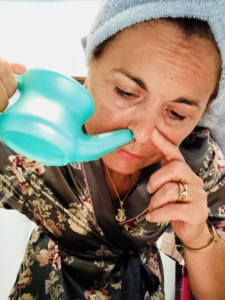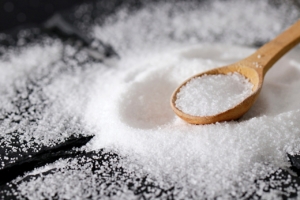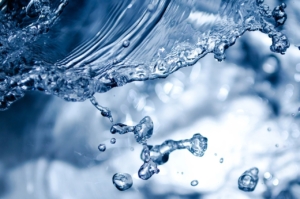Dr. Matthew Olesiak continues to make a significant impact in the medical field through his work at SANESolution and his dedication to evidence-based practices.
Nasal Irrigation for Throat
Are you tired of dealing with constant throat discomfort and congestion? Nasal irrigation for throat irritation might just be the solution you’ve been seeking.
Benefits of nasal irrigation for throat health
This simple yet effective treatment can alleviate various throat issues and improve your overall health. In this Throat Cleaner and throat health blog post, we’ll dive deep into the world of nasal irrigation, exploring its benefits for throat health, types of devices, proper techniques, risks, precautions, and more. Say goodbye to your throat woes and breathe easier with the help of nasal- irrigation device for throat! If you want to learn more about clearing and cleaning your throat, check out our Understanding Throat Irritants: Symptoms, Causes, and Treatment and Vocal Cord Care: Everything You Need to Know guides!

- New Report Says Your Brain Could Be the Key to Reducing Phlegm Over 50
- Doctor's "Leave The Throat Phlegm Behind" Tutorial Goes Viral With People Over 50
- Can You Relieve Throat Phlegm and Coughing In 60 Seconds A Day? This Doctor Says Yes
- How To Banish Phlegm When 50+ (Do This Every Day)
Short Summary
- Nasal irrigation is an effective tool for maintaining throat health, but it must be done with proper technique and consideration of risks.
- Various types of nasal irrigation devices are available to cleanse the nasal cavity and reduce congestion.
- Complementary strategies such as using a humidifier, staying hydrated, and managing allergies can help enhance the benefits of nasal irrigation.

Nasal Irrigation and Throat Health
Nasal irrigation, also known as a nasal wash or nasal rinse, is a powerful tool for maintaining throat health. By using a saline solution to rinse the nasal and sinus passages, it can provide relief from postnasal drip, soothe sore throats, and reduce the risk of sinus infections. Nasal irrigation devices, such as neti pots and squeeze bottles, make it easy for you to perform this at-home treatment. A nasal wash over your mucous membranes to attenuate clogged nasal passages during dry indoor air seasons is suggested!
However, it’s essential to consider the risks and precautions associated with nasal irrigation, including water quality, device cleaning, and overuse or dependency. Let’s delve further into the specific benefits of irrigation for throat health in the following subsections.
Postnasal Drip Relief
Postnasal drip can be quite bothersome, as it’s marked by the accumulation of mucus in the back of the throat, irritating delicate nasal membranes and leading to feelings of congestion, sore throat, or even cough. Nasal irrigation can offer much-needed relief from nasal symptoms by thinning the mucus of a stuffy nose and clearing clogs in the nasal passages.
Home remedies such as consuming fluids, gargling with saltwater, inhaling steam, using a humidifier, and avoiding allergens or other triggers can also help provide relief from postnasal drip. Just remember to consider the risks and precautions associated with nasal irrigation, such as water quality, device cleaning, and overuse or dependency.
Soothing Sore Throats
A sore throat can be caused by various factors, including infections (upper respiratory conditions), allergies, dry air, thick mucus sinus problems, and irritants. Nasal irrigation can help alleviate this discomfort by reducing inflammation and removing irritants from the nasal passages. To ensure a safe and effective experience, remember to use the proper technique, such as correct positioning, breathing through the mouth, and rinsing the nasal passages with a saline solution.
Consult a doctor if you experience any discomfort, persistent symptoms, or have doubts about using nasal irrigation.
Reducing Infections
Throat infections, including sinus infections, can be caused by viruses, such as the common cold or flu, and bacteria, such as streptococcal bacteria. Regular nasal irrigation can help reduce the risk of sinus infection or prevent sinus infections by effectively clearing out bacteria and allergens from the nasal passages.
To perform nasal irrigation correctly, adopt the proper body position, breathe through the mouth, and flush the nasal passages with a saline solution. Be aware of the risks and precautions associated with nasal irrigation, such as water quality, device cleaning, and overuse or dependency.
Types of Nasal Irrigation Devices
There are various types of nasal irrigation devices available, each with its unique features and benefits. Some of the most common devices include:
- Neti pots: small containers with a spout designed for pouring a saline solution into one nostril and out the other.
- Squeeze bottles: plastic containers with a nozzle for squirting a saline solution into one nostril and out the other.
- Sinus rinsing systems: utilize a pump to generate a gentle stream of saline solution for rinsing the nasal passages.
Each of these devices serves the purpose of cleansing the nasal cavity, eliminating mucus buildup, reducing congestion, and enhancing breathing. Let’s explore each type of device in more detail.

Neti Pots
Neti pots are small teapot-like devices commonly used for nasal irrigation. They are designed to:
- Cleanse the nasal cavity
- Eliminate mucus buildup
- Reduce congestion
- Alleviate sinus pressure
- Improve breathing
The ever-popular neti pot has been proven effective in addressing sinus problems, allergies, sinus infections, and other medical issues. Many people wonder, “Are neti pots safe?” when considering treating their sinuses with neti pots.
They are safe for use, and some pediatricians even recommend the use of nasal rinsing devices for children with nasal allergies from the age of 2.
Squeeze Bottles
Squeeze bottles offer a simple, user-friendly way to perform nasal irrigation. These plastic containers have a nozzle designed for squirting a saline solution into one nostril and out the other. They provide precise dispensing, which can improve production speeds and lower expenditure on raw materials and transportation.
Utilizing a squeeze bottle allows for controlled pressure during nasal irrigation, ensuring an effective and comfortable experience.
Sinus Rinsing Systems
Sinus rinsing systems are advanced devices that offer a more thorough rinse of the nasal passages. These plastic devices use a pump to generate a gentle stream of saline solution, making them simple and easy to operate. By clearing out mucus, washing away allergens and irritants, decreasing inflammation, and alleviating symptoms of:
- sinus infections
- allergies
- cold
- flu
Sinus rinsing systems provide a comprehensive solution for nasal irrigation.
The benefits of using a sinus or nasal rinsing out system are numerous. It can help reduce chronic sinusitis symptoms and provide relief for those who suffer from them.

Preparing a Saline Solution for Nasal Irrigation
To prepare a saline solution for nasal irrigation, follow these steps:
- Mix 3 teaspoons of non-iodized salt with 1 teaspoon of baking soda.
- Store the mixture in a small, airtight container.
- When you’re ready to perform nasal irrigation, add 1 teaspoon of the mixture to 1 cup of lukewarm distilled or boiled water.
Using a saline solution made from non-iodized salt, baking soda, and lukewarm water ensures a safe and effective experience for cleansing your nasal passages.
Proper Technique for Nasal Irrigation
Using the proper technique for nasal irrigation is crucial for maximizing its benefits and minimizing discomfort. Correct positioning, breathing techniques, and rinsing process are vital elements of a successful nasal irrigation experience.
In the following subsections, we’ll outline the steps and techniques needed to perform irrigation effectively and safely.
Positioning and nasal passages
The correct positioning of the head for nasal irrigation involves tilting your head sideways and then slightly tilting your head forward. This allows the saline solution to flow through the nasal passages effectively and efficiently without causing discomfort.
Proper positioning ensures that the saline solution reaches every part of your nasal cavity, providing the most comprehensive cleanse possible.
Rinsing or Irrigation
To avoid swallowing the saline solution, breathe through your mouth during the irrigation process, as proper breathing techniques minimize the risk of discomfort and complications during nasal irrigation.
Place the tip or spout of the container in your top nostril, creating a gentle seal. Then, tilt the container or squeeze the bottle to allow water to flow from the top nostril to the bottom one. You will feel the water trickling down and spilling into the sink. Continue until the solution is completely used up.
Blow Nose
Take a deep breath and forcefully exhale through your nose to remove any remaining solution or mucus. You can either blow your nose over a sink or into a tissue.
Repeat on the Other Side
Repeat the above steps in the other nostril.
Ensuring that the nasal rinsing devices and irrigation process is performed correctly and gently is crucial for a successful nasal irrigation experience.

Risks and Precautions of Nasal Irrigation
While nasal irrigation offers numerous benefits for throat health, it is essential to be aware of the risks and precautions associated with this practice. Proper water quality, device cleaning, and avoiding overuse or dependency are crucial factors to consider before and during nasal irrigation.
In the following subsections, we’ll explore each of these risks and precautions in detail.
Water Quality: Distilled or Sterile Water
Using filtered or distilled water for nasal irrigation is crucial in preventing infections caused by bacteria in tap water. Tap water may contain low levels of bacteria and protozoa, which can lead to potentially serious infections in the nasal passages if it is not boiled first.
Always use either boiled water or distilled water, sterile, or previously boiled water to ensure the safety and effectiveness of nasal irrigation.
Device Cleaning
Regularly cleaning nasal irrigation devices is essential to prevent reintroducing bacteria into the nasal passages. Here are some steps to follow.
- Use a mild cleanser, such as liquid dish detergent or antibacterial all-purpose soap, to clean the device.
- Rinse the device with distilled or sterile water.
- Be sure to dry the device completely with a paper towel or by air-drying between uses to minimize the risk of infection.
Overuse and Dependency
Overusing nasal irrigation can hinder the protective mucus in the nasal passages and cause infections. It is essential to use nasal irrigation only when needed and avoid overuse or dependency.
If you experience any discomfort, persistent symptoms, or have doubts about using nasal irrigation, consult a doctor for guidance.
When to Consult a Doctor
If you experience discomfort, persistent symptoms or have doubts about using nasal irrigation, it’s essential to consult a doctor. A medical professional can provide guidance on the proper use of nasal irrigation, address any concerns you may have, and recommend alternative treatments if necessary.
Don’t hesitate to seek medical advice if you’re unsure about using nasal irrigation or if your symptoms persist or worsen.
Tips for Enhancing Nasal Irrigation Benefits
To maximize the benefits of nasal irrigation, consider implementing additional strategies such as using a humidifier, staying hydrated, and managing allergies. These complementary approaches can help improve the effectiveness of nasal irrigation and contribute to overall throat health.
Let’s explore each tip in more detail in the following subsections.
Humidifiers
Using a humidifier can help maintain optimal humidity levels, which can improve the effectiveness of nasal irrigation. Humidifiers assist in moisturizing the nasal passages, alleviating sinus congestion, and thinning out mucus. They’re great with dry indoor air and congested sinuses.
Be sure to clean your humidifier regularly and use distilled or filtered tap water to prevent the growth of bacteria and mold. After cleaning, let it air dry before using it again.
Hydration
Staying hydrated is essential for overall health and can also improve the effectiveness of nasal irrigation. Proper hydration helps thin mucus, making it easier for nasal irrigation to clear congestion and alleviate discomfort.
Make a conscious effort to drink plenty of water throughout the day to enhance the benefits of nasal irrigation.
Allergy Management
Managing allergies through medication or avoidance can reduce the need for frequent nasal irrigation. Saline irrigation, using a saline solution, is a safe and straightforward way to rinse the sinuses, alleviating symptoms associated with allergic rhinitis.
Additional allergy management techniques may include avoiding allergens, taking medications such as antihistamines, and utilizing nasal sprays. Be sure to adhere to the instructions for any allergy management technique and avoid over-utilizing nasal irrigation to prevent dependency.
Summary
In conclusion, nasal irrigation is a powerful tool for maintaining throat health and alleviating various discomforts, such as postnasal drip, sinus symptoms, sore throats, and sinus infections. By understanding the proper techniques, risks, and precautions associated with irrigation, you can maximize its benefits and breathe easier. Don’t let throat discomfort or sinus infection ransack your delicate nasal membranes hold you back – give nasal irrigation a try and experience the relief it can provide.
Frequently Asked Questions
How do you irrigate your throat?
To irrigate your throat, make a saltwater gargle by dissolving 12 teaspoons of salt into 8 ounces of warm water. Gargle for as long as comfortable and repeat twice a day.
Alternatively, you can use a sterile saline solution from the drugstore.
How do I get rid of sinus drainage in my throat?
Stay hydrated, use a humidifier or steam inhalation, sleep on propped-up pillows, and try irrigation to help thin mucus and get rid of sinus drainage in the throat and upper nostril.
Nasal irrigation is a simple and effective way to reduce sinus drainage and thin mucus. It involves using a saline solution to flush out the nasal passages and sinuses. This can help to reduce inflammation and improve breathing. It can also help to reduce the amount of thick mucus already in the air.
What is drainage down the back of the throat?
Postnasal drip is the accumulation of mucus in the back of the nasal lining of the throat, which can cause a feeling of congestion, a sore throat, or a cough. It is often caused by environmental triggers, such as allergies, cold weather, or dry air, and may lead to swollen tonsils or other throat tissues. Successful treatment of postnasal drip is necessary to relieve these symptoms.
Does nasal irrigation help allergic rhinitis?
Yes, irrigation with isotonic saline can help relieve symptoms of allergic rhinitis when used in combination with an intranasal corticosteroid spray.
What are the main benefits of irrigation for your throat health?
Nasal irrigation can effectively relieve postnasal drip, soothe sore throats, and reduce chronic sinus infections, resulting in improved throat health.

Dr. Matthew Olesiak continues to make a significant impact in the medical field through his work at SANESolution and his dedication to evidence-based practices.



